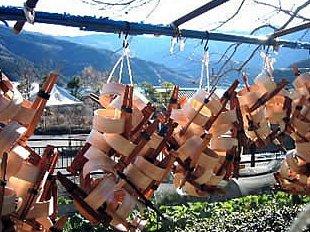|
Its original character is 气. Again, the original character of 气 is 乞, the form of moving clouds. 気 can be thought of as the basic unit of energy, be it air, atmosphere, weather, vapor, or breathing.
In ‘Explanation of Common Use Kanji,’ the last character dictionary of Dr. Shirakawa, for the first time in his dictionaries, we find his explanation commenting on the vital role of 米 ‘rice’ nurturing 気 spirit or energy. By the way, also Jacob Chang-Ui Kim from Korea gave a similar view in his English explanation of Kanji.
Food is what supplies living beings with energy. Without eating, one cannot live and there is no vitality. From ancient times on, rice is the basic food and basis of energy in East Asia.
The upper part of 気 can also be thought of as the rising steam from rice boiling, and it therefore may even be regarded as a pictograph. In Japanese, 気 came to be used in a lot of expressions describing human feelings and states of mind. In East Asia as a whole, it has become the basis of martial arts culture built on the importance of breathing techniques, as Chinese shadow boxing and Aikidō.
In ancient Greek philosophy, with ‘pneuma,’ there is a very similar notion. The Stoa, a classic school of thought that commends pantheism and a life style following the laws of nature, taught that ‘pneuma,’ the most fine matter like air, is the carrier of ‘logos,’ or world reason, extant everywhere in the universe. In this sense, 気 is (was) a common way of thinking in East and West.
In ‘Explanation of Common Use Kanji,’ the last character dictionary of Dr. Shirakawa, for the first time in his dictionaries, we find his explanation commenting on the vital role of 米 ‘rice’ nurturing 気 spirit or energy. By the way, also Jacob Chang-Ui Kim from Korea gave a similar view in his English explanation of Kanji.
Food is what supplies living beings with energy. Without eating, one cannot live and there is no vitality. From ancient times on, rice is the basic food and basis of energy in East Asia.
The upper part of 気 can also be thought of as the rising steam from rice boiling, and it therefore may even be regarded as a pictograph. In Japanese, 気 came to be used in a lot of expressions describing human feelings and states of mind. In East Asia as a whole, it has become the basis of martial arts culture built on the importance of breathing techniques, as Chinese shadow boxing and Aikidō.
In ancient Greek philosophy, with ‘pneuma,’ there is a very similar notion. The Stoa, a classic school of thought that commends pantheism and a life style following the laws of nature, taught that ‘pneuma,’ the most fine matter like air, is the carrier of ‘logos,’ or world reason, extant everywhere in the universe. In this sense, 気 is (was) a common way of thinking in East and West.
| [+ADDRESS] | 
|

















